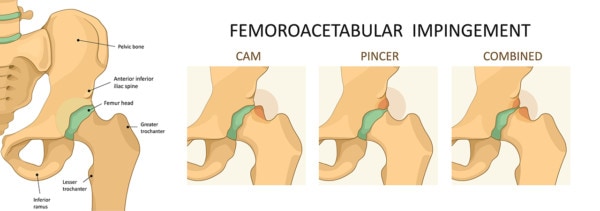Hip FAI Surgery Recovery: Everybody Has Hip FAI…
Hip FAI surgery recovery can be tough. This past decade the number of surgeries for hip impingement have exploded! The basic concept is that a small number of us are born with hips that tend to “impinge” and this extra wear and tear can rapidly lead to arthritis. As a result, if someone has an x-ray or MRI showing hip FAI (femoral-acetabular impingement) impingement with hip pain, they need a very invasive surgery to “decompress” the hip. In this case, “decompressing” means the part of the hip that’s impinging is cut out surgically and the hip is reshaped . Understandably, surgery to remove extra bone on the cup of socket called Pincer, or extra bone mishaping the head of the femur called CAM, is often associated with a long recovery.

Logika600/Shutterstock
Is FAI Impingement Rare?
At face value this may make some sense if hip FAI was an uncommon abnormality that inflicted some people born with the wrong anatomy. However, what if imaging findings of hip FAI were the norm in young healthy people with no hip pain? Prior studies have suggested that as many as a third of us who don’t have hip pain have FAI on our images.
Just How Common Is It?
A subsequent study suggested just that, that some x-ray finding of hip FAI can be found in nearly all of us. The Norwegian study looked at 2081 young adults with x-rays of their hips. Surprisingly 97.1% of the men and 98.6% of the women had at least one x-ray finding of hip FAI! Yes, you read that right. I literally had to double check the numbers in the abstract several times, and yes, almost everybody had hip impingement. The study looked at many different types of x-ray findings that are associated with hip FAI. One of the signs considered sensitive and specific for hip FAI (crossover sign) was found in 51.4%, so more than half the men!
What Do I Do If I Have It?
The upshot? If you find yourself with hip pain and an x-ray shows signs of FAI, this study would suggest caution if an invasive hip surgery is recommended. X-ray is a static image taken when you’re not moving and hip impingement occurs when you move, so using an x-ray to decide if the patient has hip FAI when just about everybody has some finding is a bad idea IMHO. To avoid this misdiagnosis, we always recommend dynamic imaging-the doctor performs an exam under live x-ray to see if the hip actually impinges when it moves. In addition, since many things can cause hip pain that have nothing to do with the hip joint (SI joint, pinched S1 nerve, muscle trigger points), an injection of your hip needs to be performed with imaging guidance to make sure the pain goes away. Again, as this study shows, just relying on a single x-ray sign of hip FAI to nail the diagnosis is fraught with problems!

If you have questions or comments about this blog post, please email us at [email protected]
NOTE: This blog post provides general information to help the reader better understand regenerative medicine, musculoskeletal health, and related subjects. All content provided in this blog, website, or any linked materials, including text, graphics, images, patient profiles, outcomes, and information, are not intended and should not be considered or used as a substitute for medical advice, diagnosis, or treatment. Please always consult with a professional and certified healthcare provider to discuss if a treatment is right for you.